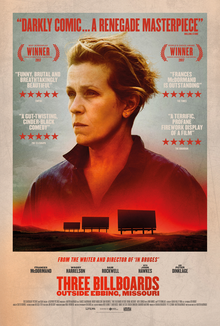 Three Billboards Outside Ebbing, Missouri
Three Billboards Outside Ebbing, Missouri
Year: 2017
Rating: R
Length: 115 minutes / 1.92 hours
The first film by Martin McDonagh I saw was Seven Psychopaths (2012). I enjoyed how he was able to take the audience through many entertaining twists and turns. For his follow-up film, Three Billboards Outside Ebbing, Missouri (2017), McDonagh has improved on the twists, as well as the darkness of the comedy contained therein. In fact, the comedy is so dark that at times it was almost uncomfortable to laugh. All this being said, the two areas that make this a standout film are the characters and its complexity.
Let’s start with the characters. Almost every single character is introduced in a way that the audience wants to dislike them. And yet, over the course of the film, the significant amount of character development makes the audience root for people who threw individuals out of second-story windows or chucked Molotov cocktails at a police station. Part of what helps in these character developments are the twists that add to the complexity of the story. Nothing is a foregone conclusion in Three Billboards, and in that sense, it has some semblance of reality to it.
On top of these two outstanding characteristics, Three Billboards is also extremely relevant. Set in that portion of mid-west America that seems to embrace the status quo over all else, even if this status quo defends and condones racism, violence, and sexual assault, the fiercely loyal townspeople turn into the real villains. Throughout all of these injustices, a small amount of hope remains, giving many individuals the modicum of energy needed to live in a society that seems to be against them at every turn. It’s a good thing this movie had some funny moments because otherwise, it would have been a sad reflection of our current affairs.
A sharp, smart, and relevant movie with complex characters and plot, I give Three Billboards Outside Ebbing, Missouri 5.0 stars out of 5.





